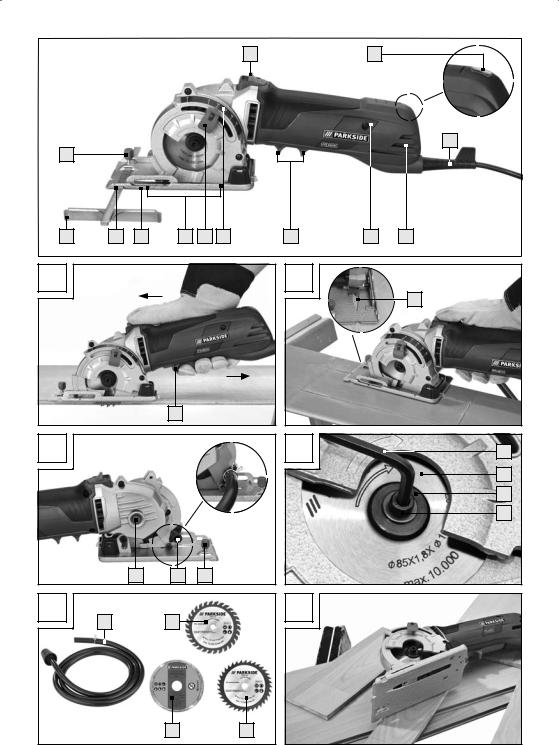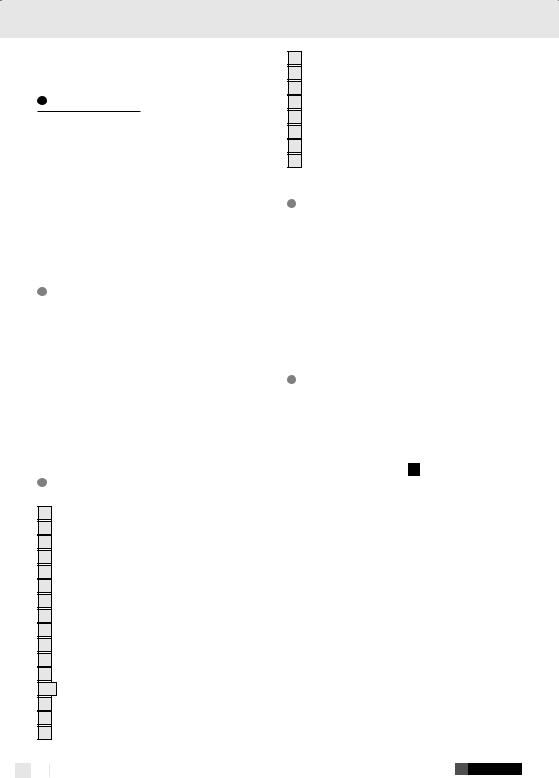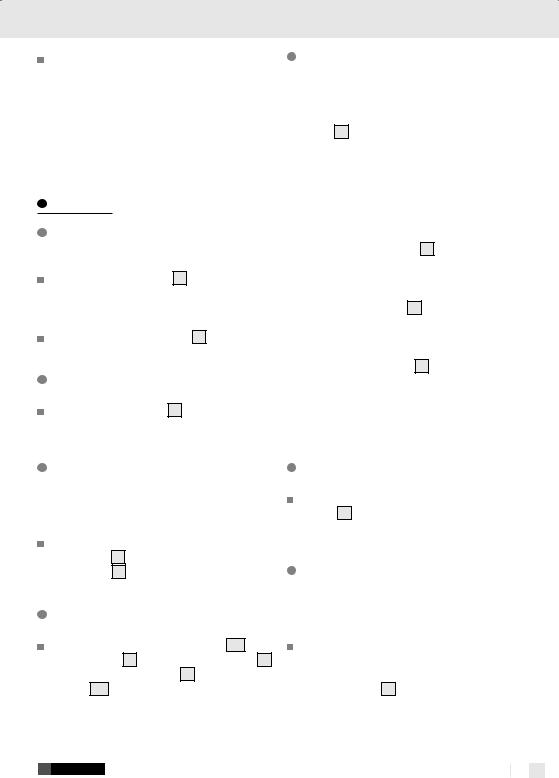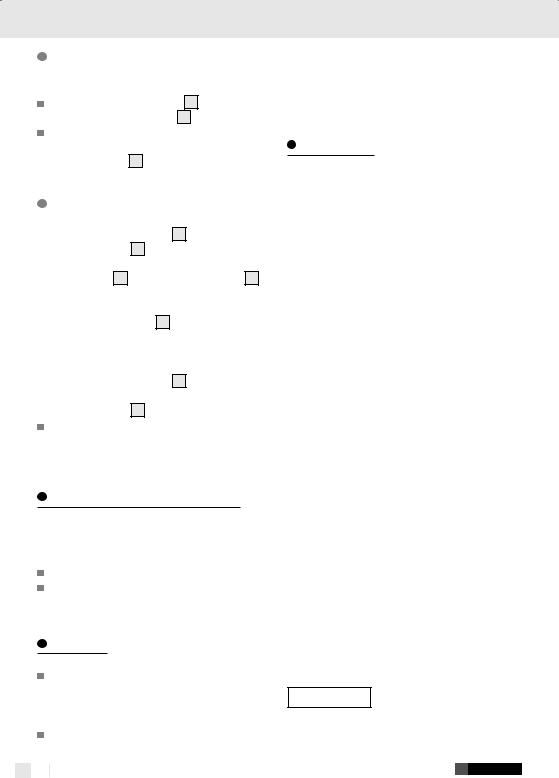Parkside PTS 480 A1 User Manual [cs, en, pl, de]

PLUNGE SAW PTS 480 A1
PLUNGE SAW |
PIŁA WGŁĘBNA |
||
Operation and Safety Notes |
Wskazówki dotyczące obsługi i bezpieczeństwa |
||
Translation of original operation manual |
Tłumaczenie oryginalnej instrukcji obsługi |
||
POTOPNA ŽAGA |
PONORNÁ PILA |
||
Navodila za upravljanje in varnostna opozorila |
Pokyny pro obsluhu a bezpečnostní pokyny |
||
Prevod |
originalnega navodila za uporabo |
Překlad |
originálního provozního návodu |
PONORNÁ PÍLA |
TAUCHSÄGE |
||
Pokyny pre obsluhu a bezpečnostné pokyny |
Bedienungs - und Sicherheitshinweise |
||
Preklad |
originálneho návodu na obsluhu |
Originalbetriebsanleitung |
|
IAN 79416

Before reading, unfold the page containing the illustrations and familiarise yourself with all functions of the device.
Przed przeczytaniem proszę rozłożyć stronę z ilustracjami, a następnie proszę zapoznać się z wszystkimi funkcjami urządzenia.
Pred branjem odprite stran s slikami in se nato seznanite z vsemi funkcijami naprave.
Před čtením si otevřete stranu s obrázky a potom se seznamte se všemi funkcemi přístroje.
Pred čítaním si odklopte stranu s obrázkami a potom sa oboznámte so všetkými funkciami prístroja.
Klappen Sie vor dem Lesen die Seite mit den Abbildungen aus und machen Sie sich anschließend mit allen Funktionen des Gerätes vertraut.
GB |
Operation and Safety Notes |
Page |
5 |
PL |
Wskazówki dotyczące obsługi i bezpieczeństwa |
Strona |
15 |
SI |
Navodila za upravljanje in varnostna opozorila |
Stran |
25 |
CZ |
Pokyny pro obsluhu a bezpečnostní pokyny |
Strana |
35 |
SK |
Pokyny pre obsluhu a bezpečnostné pokyny |
Strana |
45 |
DE / AT / CH |
Bedienungsund Sicherheitshinweise |
Seite |
55 |

|
|
|
|
|
1 |
11a |
|
|
|
|
|
11 |
10 |
9 |
8 |
7 |
7a |
A |
|
|
|
|
|
|
|
|
6 |
|
|
C |
|
|
|
|
|
|
|
13 |
14 |
11a |
|
E |
19 |
|
20 |
|
|
|
|
|
|
||
|
|
|
21 |
|
22 |
|
2 |
|
|
|
3 |
6 |
5 |
4 |
B |
|
|
|
|
12 |
D |
|
15 |
|
|
16 |
|
|
17 |
|
|
18 |
F |
|
|


Table of contents
Introduction |
|
|
Intended use......................................................................................................................................... |
Page |
6 |
Features................................................................................................................................................ |
Page |
6 |
Scope of delivery................................................................................................................................. |
Page |
6 |
Technical Data..................................................................................................................................... |
Page |
6 |
General safety advice for electrical power tools |
|
|
1. Workplace safety............................................................................................................................ |
Page |
7 |
2. Electrical safety............................................................................................................................... |
Page |
7 |
3. Personal safety................................................................................................................................ |
Page |
7 |
4. Careful handling and use of the electrical power tool................................................................. |
Page |
8 |
5. Service............................................................................................................................................. |
Page |
8 |
Safety instructions for all saws............................................................................................................ |
Page |
9 |
Safety instructions for plunge saws.................................................................................................... |
Page 10 |
|
Safety recommendations for the correct use of superabrasives....................................................... |
Page 10 |
|
Start-up |
|
|
Switching on and off........................................................................................................................... |
Page 11 |
|
Releasing the plunge blocker.............................................................................................................. |
Page 11 |
|
Preselect cutting depth......................................................................................................................... |
Page 11 |
|
Fitting the guide fence......................................................................................................................... |
Page 11 |
|
Handling the plunge saw.................................................................................................................... |
Page 11 |
|
Marking cutting length........................................................................................................................ |
Page 11 |
|
Marking cutting line............................................................................................................................. |
Page 11 |
|
Connecting the saw dust extraction................................................................................................... |
Page 12 |
|
Replacing the saw blade.................................................................................................................... |
Page 12 |
|
Maintenance and Cleaning............................................................................................... |
Page 12 |
|
Service................................................................................................................................................ |
Page 12 |
|
Warranty......................................................................................................................................... |
Page 12 |
|
Disposal............................................................................................................................................. |
Page 13 |
|
Declaration of Conformity / Manufacturer.......................................................... |
Page 13 |
|
GB 5

Introduction
Plunge saw PTS 480 A1
Introduction
Congratulations on your purchase. You have selected a high quality product. The instructions for use are a part of this product. They contain important information about safety, use and disposal. Before using the product, please familiarise yourself with all the operating and safety instructions. Use the product only as described and for the specified applications. When passing this product on to others please be sure to also include all of its documentation.
Intended use
The machine is primarily intended for lengthwise and across cuts in plunge cut with solid support in solid wood, chipboard, plywood, aluminium, tiles, stone, plastic and lightweight construction materials. Please keep in mind that the pre-fitted saw blade is only suitable for cutting wood. Any other uses, and / or modifications to the appliance, are deemed to be improper usage and may result in serious physical injury. Not for commercial applications.
Features
1Mechanical plunge blocker
2Power On / Control LED
3Mains lead
4Ventilation slits
5Cover for brushes
6ON /OFF switch
7Pre-selector for cutting depth 7a Scale for cutting depth
8Labelling cutting length
9Base plate
10Uptake parallel fence
11Parallel fence
11a Screw for parallel fence
12Window for cutting line
13Spindle lock
14Connection for dust extraction
6 GB
15Allen key
16Saw blade
17Clamping flange
18Clamping screw and washer
19Dust extractor hose
20HW-Circular saw blade Z85 / 30
21Diamond cutting disc Z85VR
22HS Circular saw blade Z85 / 36
Scope of delivery
1 Plunge saw PTS 480 A1
1 HW Circular saw blade Z85 / 30
1 Diamond cutting disc Z85VR
1 HS Circular saw blade Z85 / 36
1 Parallel fence
1 Dust extractor hose
1 Allen key
1 Set of operating instructions
Technical Data
Rated power: |
480 W |
Rated voltage: |
230 V , 50 Hz |
Idling speed: |
n0 4500 min-1 |
Max. cutting depth: |
25 mm |
Protection class: |
II / |
Noise and vibration data:
Measurement for noise level, determined according to EN 60745. The A-rated noise levels of the electrical power tool are typically at:
Sound pressure level: |
82 dB(A) |
Sound power level: |
93 dB(A) |
Uncertainty K: |
3 dB |
Wear hearing protection!
Evaluated acceleration, typically:
Hand / arm vibration ah = 2.266 m / s2 Uncertainty K = 1.5 m / s2

 The vibration level given in these operating instructions has been measured in a procedure according to EN 60745 and can be used
The vibration level given in these operating instructions has been measured in a procedure according to EN 60745 and can be used

Introduction / General safety advice for electrical power tools
for the comparison of appliances. The vibration emission value specified can also serve as a preliminary assessment of the exposure.
Different uses of the device give rise to different vibration levels and in many cases they may exceed the values given in these instructions. It is easy to underestimate the vibration load if the electrical power tool is used regularly in particular circumstances.
Note: If you wish to make an accurate assessment of the vibration loads experienced during a particular period of work, you should also take into account the intervening periods of time when the device is switched off or is running but is not actually in use. This can result in a much lower vibration load over the whole of the work period.
General safety advice for electrical power tools

 Please read all safety information and instructions. Failure to observe the safety information and instructions can result in electric shock, fire and / or serious injury.
Please read all safety information and instructions. Failure to observe the safety information and instructions can result in electric shock, fire and / or serious injury.
For future reference keep all the safety advice and instructions in a safe place.
The term “electrical tool” used in the safety advice refers to electrical tools powered by mains electricity (by means of a mains lead) and electrical tools powered by rechargeable batteries (without a mains lead).
1. Workplace safety
a)Keep your working area clean and well lit. Untidy or poorly lit working areas can lead to accidents.
b)Do not work with the device in potentially explosive environments, which contain inflammable liquids, gases or dusts. Electrical power tools create sparks, which can ignite dusts or fumes.
c)Keep children and other people away while you are operating the electrical tool. Distractions can cause you to lose control of the device.
2. Electrical safety
a)The mains plug on the device must match the mains socket. The plug must not be modified in any way. Do not use an adapter plug with devices fitted with a protective earth. Unmodified plugs and matching sockets reduce the risk of electric shock.
b)Avoid touching grounded surfaces such as pipes, radiators, ovens, and refrigerators. There is an increased risk of electric shock if your body is earthed.
c)Keep the appliance away from rain or moisture. The penetration of water into the electrical device increases the risk of an electric shock.
d)Do not use the mains lead for purposes it was not intended for, e.g. to carry the device, to hang up the device or to pull the mains plug out of the mains socket. Keep the mains lead away from heat, oil, sharp edges or moving parts of the device. Damaged or tangled cables increase the risk of an electric shock.
e)If you are working outdoors with an electrical power tool, always use extension cords that are approved for outdoor use. The use of an extension cable suitable for outdoor use reduces the risk of electric shock.
f)Use a residual current device (RCD) for protection if the operation of the electrical power tool in a moist environment cannot be avoided. The use of an RCD reduces the risk of electric shock.
3. Personal safety
a)Remain alert at all times, watch what you are doing and always proceed
GB 7

General safety advice for electrical power tools
with caution when using an electrical tool. Do not use the electrical power tool if you are tired or under the influence of drugs, alcohol or medication.
One moment of carelessness when using the electrical power tool can lead to serious injury.
b)Always wear protective equipment and wear safety glasses. Depending on the type of electrical tool and its application, wearing personal protective equipment such as ear protection, dust mask or work gloves reduces the risk of injuries.
c)Avoid unintentional operation of the device. Check that the electrical power tool is switched off before you connect it to the mains, pick it up or carry it.
Accidents can happen if you carry the electrical tool with your finger on the ON / OFF switch or with the device switched on.
d)Remove any setting tools or spanners before you switch on the electrical tool.
A tool or spanner left attached to a rotating part of an electrical tool can lead to injury.
e)Avoid placing your body in an unnatural position. Keep proper footing and balance at all times. By doing this, you will be in a better position to control the electrical power tool in unforeseen circumstances.
f)Wear suitable clothing. Do not wear loose clothing or jewellery. Keep your hair, clothing and gloves clear of moving parts. Loose clothing, jewellery or long hair can become trapped in moving parts.
g)If vacuum dust extraction and collection devices are fitted, do not forget to check that they are properly connected and used correctly. The use of dust extraction reduces the hazard presented by dust.
b)Do not use an electrical power tool if its switch is defective. An electrical power tool that can no longer be switched on and off is dangerous and must be repaired.
c)Pull the mains plug from the socket before you make any adjustments to the appliance, change accessories or when the device is laid aside. This precaution prevents the unintentional start of the electrical tool.
d)Always ensure that electrical power tools are kept out of reach of children when not in use. Do not let anyone use the device if they are not familiar with it or have not read the instructions and advice. Electrical power tools are dangerous when they are used by inexperienced persons.
e)Maintain the electrical power tool carefully. Check that moving parts are working properly and move freely. Check for any parts that are broken or damaged enough to detrimentally affect the functioning of the electrical power tool. Have damaged parts repaired before you use the device. Many accidents have their origins in poorly maintained electrical power tools.
f)Keep cutting tools clean and sharp.
Carefully maintained cutting tools with sharp cutting edges are less likely to jam and are easier to control.
g)Use the electrical power tool, accessories, inserted tools etc. in accordance with these instructions. When doing this, take the working conditions into consideration, as well as the task at hand. The use of electrical power tools for purposes other than those intended can lead to dangerous situations.
4.Careful handling and use of the electrical power tool
a)Do not overload the device. Always use an electrical power tool that is intended for the task you are undertaking. By using the right electrical power tool for the job, you will work safer and achieve a better result.
8 GB
5. Service
a)Only have electrical power tools repaired by qualified specialist personnel using OEM spare parts. This ensures that the safety of the electrical power tool is maintained.

General safety advice for electrical power tools / Start-up
Hold the device by the insulated handle surfaces when performing work where there is danger of the tool used striking hidden electrical lines or its own power cable. Contact with a live wire could cause metal parts of the device to become live and lead to electric shock.
Safety instructions for all saws
a) DANGER: Stay with your hands out of the cutting area and keep off the cutting disc. If you hold the saw with both hands, they cannot be injured by the saw blade.
DANGER: Stay with your hands out of the cutting area and keep off the cutting disc. If you hold the saw with both hands, they cannot be injured by the saw blade.
b)Do not reach underneath the workpiece. The protective cover will not protect you from the saw blade under the work piece.
c)Adjust the cutting depth to the thickness of the work piece. Less than the full width of a tooth should be visible from under the work piece.
d)Never hold the workpiece with the hand or lay it over a leg. Secure the workpiece on a stable fixture. It is important to fix the work piece safely, to minimise the danger of contact with the body, jamming of the saw blade or loss of control.
e)Hold the electrical power tool by the insulated handle surfaces when you are undertaking work where there is the danger of the tool striking hidden electricity cables or the device’s mains lead. Contact with a live wire could cause metal parts of the electrical power tool to become live and lead to electric shock.
f)When cutting along the way always use a fence or a straight edge guide.
That improves the precision of the cut and minimises the possibility that the saw blade jams.
g)Always use saw blades of the correct size and with matching mounting hole (e.g. star-shaped or round). Saw blades not matching the attachments of the saw run untrue and lead to loss of control.
h)Never use damaged or wrong saw blade washers or bolts. The saw blade washers and screws were specifically devel-
oped for your saw, for optimal performance and operating security.
Reasons for and how to avoid a kickback:
-A kickback is the sudden reaction, if the saw blade sticks, jams or is misaligned and the uncontrolled saw moves out of the work piece in the direction of the operator.
-If the saw blade wedges, sticks or jams itself into the closing saw gap, it blocks and the motor power kicks the saw back into the direction of the operator.
-If the saw blade is twisted or wrongly aligned in the saw gap, the teeth of the rear blade edge can jam in the surface of the work piece, causing the saw blade to move out of the saw gap and the saw to jump back in the direction of the operator.
A kickback is the result of wrong or unsuitable use of the saw. It can be avoided by taking the in the following described precautions.
a)Hold the saw with both hands and bring your arms into a position that allows you to absorb the forces of the kickback. Always stand to the side of the saw blade, never bring the saw blade into a line with your body. During a kickback the saw can jump backwards, however, the operator can master the forces of the kickback with suitable preventive measures.
b)Should the saw blade jam, or you stop the work, switch the saw off and hold it still in the work piece, until the saw blade has come to a standstill. Never attempt to remove the saw from the work piece or to pull it backwards, as long as the saw blade moves, as otherwise a kickback could occur. Find out and rectify the reason for the jamming of the saw blade.
c)If you want to restart a saw that is stuck in the workpiece, centre the saw blade in the saw gap and check that the teeth are not stuck in the workpiece. If the saw blade jams, it can move out of the work
GB 9

General safety advice for electrical power tools
piece or cause a kickback, when the saw is started anew.
d)Support big boards to reduce the risk of a kickback due to a jamming saw blade. Big boards can bend through due to their own weight. Boards must be supported on both sides, at the outside and near the cutting edge.
e)Do not use blunt or damaged saw blades. Saw blades with blunt or wrongly set teeth cause increased friction, jamming of the blade and kickback due to a saw gap that is too tight.
f)Tighten the adjustments for cutting depth and cutting angle before starting to cut. If the adjustments change during cutting, the saw blade can jam and cause a kickback.
g)Take particular care, when plunge cutting into existing walls or other areas that you cannot inspect. The saw blade can jam when cutting into hidden objects and thereby causing a kickback.
Safety instructions for plunge saws
a)Before every use check that the safety cover closes without problems. Do not use the saw, if the safety cover does not move freely and does not close instantly. Never fix or tie back the safety cover in the opened position. If the saw is dropped accidentally, the safety cover can be bent. Ensure that the safety cover moves freely and does not touch either the saw blade or other parts.
b)Check condition and function of the safety cover spring. If safety cover and spring do not work faultlessly, get the saw serviced before using it.
Damaged parts, sticky deposits or masses of wood shavings lead to delayed operation of the bottom safety cover.
c)If you plunge cut at angles other than right angles, secure the guide plate of the saw to prevent sliding sideways.
10 GB
Lateral movement can lead to jamming of the saw blade and therewith to kickback.
d)Do not put the saw done on the bench or on the floor without covering the saw blade with the safety cover. An unprotected saw blade moves the saw against the direction of the cut, and cuts everything that is in the way. Please keep in mind that the saw runs on.
Please ensure that only persons over 16 years of age operate this appliance according to the instructions in this operating instructions!
Note: Do not use grinding discs. Injuries and damage to objects could result.
Safety recommendations for the correct use of superabrasives
a) General
Superabrasives are breakable and shall therefore be handled with utmost care! The use of damaged or improperly mounted or used superabrasives is dangerous and can cause serious injuries.
b) Delivery, handling and storage
Superabrasives shall be handled and transportes with care. Superabrasives shall be stored in such a manner that they are not subjected to mechanical damages and harmful environmental influences.
Avoid the danger of death from electric shock:
Regularly check the condition of the appliance, mains cable and plug. Do not operate appliances with damaged parts of that description. Never open the appliance. Damaged appliances, mains cables or plugs main danger to life due to electric shock. Always have repairs or parts exchanges carried out at the service centre or by an electrician.
Do not operate the appliance when it is wet or in damp environments.

General safety advice for electrical power tools / Start-up
If you work outside, connect the device to a residual current (RCD) protective switch with a maximum 30 mA tripping current. Only use extension leads approved for outdoor use.
Note: Always hold the mains cable out of the operating range of the machine and move it towards the back of the machine.
Start-up
Switching on and off
Switching on:
Pull the ON / OFF switch 6 towards the back (see Fig. A).
Switching off:
Release the ON / OFF switch 6 .
Releasing the plunge blocker
Push the plunge blocker 1 towards the front and keep it pressed.
Handling the plunge saw
1.Put the machine onto the material and switch it on as described in the chapter “Switching on and off”.
2.If necessary adjust the machine to the guide fence 11 or a drawn line.
3.Hold the machine as shown in Figure A and cut with light pressure.
Types of saw blades:
The saw blades included cover the most common types of application.
HW Circular saw blade 20 Z85 / 30:
Description: ø 85 mm, 30 HW-teeth
Suitable for: Soft wood, hard wood, boards of any type
Diamond cutting disc 21 Z85VR:
Description: ø 85 mm, without teeth
Suitable for: Ceramics, plastics
HS Circular saw blade 22 Z85 / 36:
Description: ø 85 mm, 36 teeth – tooth setting left / right
Suitable for: Soft wood, soft metals such as aluminium, copper
Preselect cutting depth |
Marking cutting length |
Note: We recommend adjusting the cutting depth at least 2 mm deeper than the thickness of the material. This will result in a clean cut.
Release the quick release of the cutting depth pre-selector 7 , adjust the desired cutting depth at the scale 7a and refit the quick release.
Fitting the guide fence
Release the screw of the guide fence 11a at the base plate 9 and insert the guide fence 11 into the guide fence fixture 10 . Retighten these screws 11a .
Orient yourself at the markings for the cutting length 8 , in order to check where your cut starts and ends.
Marking cutting line
The cutting line viewing window allows precise guidance of the machine along the cutting line applied to the workpiece.
In order to achieve an exact cut, place the machine on the workpiece so that the cutting length labelling appears in the cutting line viewing window 12 , as depicted in Illustration B.
GB 11

Start-up / Maintenance and Cleaning / Service / Warranty
Connecting the saw dust extraction
Push the extraction air hose 19 onto the connection for dust extraction 14 .
Connect a vacuum device approved for the extraction of sawdust and splinters to the dust extraction hose 19 .
Replacing the saw blade
1.Operate the spindle lock 13 and loosen the clamping screw 18 with the Allen key (to open turn clockwise). Now lift off the clamping screw and washer 18 and the clamping flange 17 (see also Fig.D).
2.Adjust cutting depth to the maximum position.
3.Swing the base plate 9 upwards.
4.Take off the saw blade.
5.Refitting of the saw blade is the reversal of the removal.
6.Operate the spindle lock 13 (until it clicks into place) and, using the Allen key, tighten the clamping screw 18 .
The arrow on the saw blade must coincide with the arrow for the direction of rotation  (marked on the appliance).
(marked on the appliance).
Maintenance and Cleaning

 DANGER OF INJURY! Remove the mains plug from the mains socket before you carry out any work on the appliance.
DANGER OF INJURY! Remove the mains plug from the mains socket before you carry out any work on the appliance.
Clean the appliance after finishing work.
To clean the appliance, use a cloth and do not use petrol, solvents or cleaning fluids.
Service

 Have your appliance repaired by qualified specialist personnel using OEM parts only. This ensures that the safety of the device is maintained.
Have your appliance repaired by qualified specialist personnel using OEM parts only. This ensures that the safety of the device is maintained.

 If the plug or mains lead needs to be replaced, always
If the plug or mains lead needs to be replaced, always
12 GB
have the replacement carried out by the manufacturer or its service centre.
This ensures that the safety of the device is maintained.
Warranty
The warranty for this appliance is for 3 years from the date of purchase. The
device has been manufactured with care and meticulously examined before delivery. Please retain your receipt as proof of purchase. In the event of a warranty claim, please make contact by telephone with our Service Department. Only in this way can a free post despatch for your goods be assured.
The warranty covers only claims for material and manufacturing defects, but not for transport damage, for wearing parts or for damage to fragile components, e.g. buttons or batteries. This product is intended for private, non-commercial use only.
The warranty is void in the case of abusive and improper handling, use of force and internal tampering not carried out by our authorized service branch. This warranty does not limit your legal rights.
The warranty period will not be extended by repairs made under warranty. This applies also to replaced and repaired parts. Any damage and defects extant on purchase must be reported immediately after unpacking the device, at the latest, two days after the purchase date. Repairs made after the expiration of the warranty period are subject to a charge.
GB
Service Great Britain Tel.: 0871 5000 720
(0,10 GBP/Min.) e-mail: kompernass@lidl.co.uk
IAN 79416

Disposal / Declaration of Conformity / Manufacturer
Disposal
The packaging is made of environmentally friendly materials, which may be disposed through your local recycling acilities.
Do not dispose of electrical power tools with household waste!
According to European Directive 2002 / 96 / EC, used electrical goods must be collected and recycled in an environmentally friendly manner.
Contact your local refuse disposal authority for more details of how to dispose of your worn out electrical appliance.
Declaration of Conformity /
Manufacturer 

We, Kompernaß GmbH, the person responsible for documents: Mr Semi Uguzlu, Burgstr. 21, D-44867 Bochum, Germany, hereby declare that this product complies with the following standards, norm documents and EU Directives:
Directive on Machinery (2006 / 42 / EC)
EU Low Voltage Directive (2006 / 95 / EC)
Electromagnetic Compatibility (2004 / 108 / EC)
RoHS Directive (2011 / 65 / EU)
Applicable harmonised standards
EN 60745-1/A11:2010 EN 60745-2-5:2010 EN 60745-2-22:2011 EN 55014-1/A2:2011 EN 55014-2/A2:2008 EN 61000-3-2/A2:2009 EN 61000-3-3:2008
Type designation of the machine:
Plunge saw PTS 480 A1
Date of manufacture: 12–2012
Serial number: IAN 79416
Bochum, 31.12.2012
Semi Uguzlu
- Quality Manager -
We reserve the right to make technical modifications in the course of product development.
GB 13

14

Spis zawartości
Instrukcja |
|
|
Użycie zgodne z przeznaczeniem.................................................................................................. |
Strona |
16 |
Wyposażenie.................................................................................................................................... |
Strona 16 |
|
Zawartość......................................................................................................................................... |
Strona |
16 |
Dane techniczne............................................................................................................................... |
Strona |
16 |
Ogólne wskazówki bezpieczeństwa dla elektronarzędzi |
|
|
1. Bezpieczeństwo miejsca pracy................................................................................................... |
Strona |
17 |
2. Bezpieczeństwo elektryczne....................................................................................................... |
Strona |
17 |
3. Bezpieczeństwo osób.................................................................................................................. |
Strona |
18 |
4. Stosowanie i obchodzenie się z narzędziami elektrycznymi.................................................... |
Strona |
18 |
5. Serwis............................................................................................................................................ |
Strona |
19 |
Wskazówki bezpieczeństwa dla pił............................................................................................... |
Strona |
19 |
Wskazówki bezpieczeństwa dla pilarek do wcięć głębnych....................................................... |
Strona |
20 |
Wskazówki bezpieczeństwa dla narzędzi szlifujących................................................................ |
Strona |
21 |
Uruchamianie |
|
|
Włączanie i wyłączanie.................................................................................................................. |
Strona |
21 |
Luzowanie blokady wgłębienia....................................................................................................... |
Strona |
21 |
Wybieranie głębokości cięcia......................................................................................................... |
Strona |
22 |
Montaż zderzaka równoległego.................................................................................................... |
Strona 22 |
|
Obsługa pilarki do cięcia wgłębnego............................................................................................ |
Strona |
22 |
Zaznaczenie długości cięcia........................................................................................................... |
Strona |
22 |
Zaznaczenie linii cięcia.................................................................................................................... |
Strona |
22 |
Podłączenie odsysania wiórów....................................................................................................... |
Strona |
22 |
Wymiana brzeszczotu..................................................................................................................... |
Strona 22 |
|
Konserwacja i czyszczenie............................................................................................ |
Strona |
23 |
Serwis.............................................................................................................................................. |
Strona |
23 |
Gwarancja................................................................................................................................... |
Strona |
23 |
Utylizacja...................................................................................................................................... |
Strona |
23 |
Deklaracja zgodności / Producent........................................................................... |
Strona |
24 |
PL 15

Instrukcja
Piła wgłębna PTS 480 A1
Instrukcja
Gratulujemy Państwu zakupu nowego urządzenia. Zdecydowali się Państwo na zakup produktu najwyższej jakości. Instrukcja obsługi jest częścią tego produktu. Zawiera ona ważne wskazówki dotyczące bezpieczeństwa obsługi, użytkowania i utylizacji produktu. Przed pierwszym użyciem produktu należy zapoznać się ze wszystkimi wskazówkami dotyczącymi obsługi i bezpieczeństwa. Produktu używać wyłącznie zgodnie z jego poniżej opisanym przeznaczeniem. W przypadku przekazania produktu należy dołączyć do niego całą jego dokumentację.
Użycie zgodne z przeznaczeniem
Maszyna jest przeznaczona przede wszystkim do wgłębnego piłowania podłużnego i poprzecznego w stabilnym podłożu jak lite drewno, płyty wiórowe, sklejki, aluminium, kafelki, kamień, tworzywo sztuczne i lekkie materiały budowlane. Należy przy tym uwzględnić, że już zamontowany brzeszczot piły nadaje się wyłącznie do użycia w drewnie. Stosowanie urządzenie do innych celów lub dokonywanie jego modyfikacji jest uznawane jako sprzeczne z jego przeznaczeniem i stwarza znaczne zagrożenie wypadkiem. Nie do użytku przemysłowego.
Wyposażenie
1Mechaniczna blokada wgłębiania
2Dioda LED kontrolna / podłączenia do sieci
3Przewód sieciowy
4Szczeliny wentylacyjne
5Pokrywa szczotek węglowych
6WŁĄCZNIK / WYŁĄCZNIK
7Wybór głębokości cięcia
7a Skala dla głębokości cięcia
8Zaznaczenia długości cięcia
9Podstawa
10 Przyjęcie zderzaka równoległego
16 PL
11 Zderzak równoległy
11a Śruba do zderzaka równoległego
12Okienko linii cięcia
13Blokada wrzeciona
14Przyłącze do odsysania pyłu
15Klucz trzpieniowy
16Brzeszczot piły
17Kołnierz zaciskowy
18Śruba naprężająca i podkładka
19Wąż odsysający
20Okrągły brzeszczot HW Z85 / 30
21Brzeszczot diamentowy Z85VR
22Okrągły brzeszczot HS Z85 / 36
Zawartość
1 pilarka do cięć wgłębnych PTS 480 A1
1 okrągły brzeszczot HW Z85 / 30
1 brzeszczot diamentowy Z85VR
1 okrągły brzeszczot HS Z85 / 36
1 zderzak równoległy
1 wąż odsysający
1 klucz trzpieniowy
1 instrukcja obsługi
Dane techniczne
Moc znamionowa: |
480 W |
Napięcie znamionowe: |
230 V , 50 Hz |
Liczba obrotów biegu |
|
jałowego: |
n0 4500 min-1 |
Maks. Głębokośći cięcia: |
25mm |
Klasa ochrony: |
II / |
Informacje dotyczące hałasu i wibracji:
Wartość pomiarowa hałasu uzyskana zgodnie z EN 60745. Poziom hałasu oceniony na A wynosi typowo:
Poziom ciśnienia akustycznego: |
82 dB(A) |
Poziom mocy akustycznej: |
93 dB(A) |
Niepewność pomiaru K: |
3 dB |
Zakładać ochraniacze na uszy!

Instrukcja / Ogólne wskazówki bezpieczeństwa dla elektronarzędzi
Oszacowane przyspieszenie, typowo:
Wibracja dłoni / ręki ah = 12,669 m / s2 Niepewność pomiaru K = 1,5 m / s2

 Podany w niniejszych instrukcjach poziom drgań wyznaczony został za pomocą metody pomiarowej określonej w normie EN 60745 i może zostać użyty do porównania urządzeń. Podany poziom emisji drgań może być wykorzystywany również do wstępnego oszacowania przerw w działaniu.
Podany w niniejszych instrukcjach poziom drgań wyznaczony został za pomocą metody pomiarowej określonej w normie EN 60745 i może zostać użyty do porównania urządzeń. Podany poziom emisji drgań może być wykorzystywany również do wstępnego oszacowania przerw w działaniu.
Poziom drgań będzie się różnił w zależności od zastosowania elektronarzędzia i w niektórych przypadkach może przekroczyć wartość podaną w niniejszej instrukcji. Obciążenie drganiami może wydawać się mniejsze niż w rzeczywistości, jeśli elektronarzędzie będzie regularnie używane ten sposób.
Wskazówka: Celem dokładnego oszacowania obciążenia wibracjami w okresie określonego okresu czasu pracy należy uwzględnić również te okresy, w których urządzenie jest wyłączone lub wprawdzie jest włączone, ale w rzeczywistości nie pracuje.
Może to przyczynić się do znacznej redukcji obciążenia wibracjami w całym okresie czasu pracy.
Ogólne wskazówki bezpie- czeństwa dla elektronarzędzi

 Należy przeczytać wszystkie wskazówki dotyczące bezpieczeństwa i instrukcje. Zaniedbania w przestrzeganiu wskazówek bezpieczeństwa i instrukcji mogą spowodować porażenie prądem elektrycznym, pożar i / lub ciężkie obrażenia ciała.
Należy przeczytać wszystkie wskazówki dotyczące bezpieczeństwa i instrukcje. Zaniedbania w przestrzeganiu wskazówek bezpieczeństwa i instrukcji mogą spowodować porażenie prądem elektrycznym, pożar i / lub ciężkie obrażenia ciała.
Należy zachować wszystkie wskazówki dotyczące bezpieczeństwa oraz instrukcje.
Używany we wskazówkach dotyczących bezpieczeństwa termin „narzędzie elektryczne“ odnosi się do narzędzi elektrycznych zasilanych z sieci (z kablem sieciowym) oraz do narzędzi elektrycznych zasilanych z akumulatorów (bez kabla sieciowego).
1. Bezpieczeństwo miejsca pracy
a)Stanowisko pracy należy utrzymywać w czystości i dobrze oświetlone. Nieporządek i brak oświetlenia w miejscu pracy może prowadzić do wypadków.
b)Nie należy pracować przy użyciu urządzenia w otoczeniu zagrożonym eksplozją, w którym znajdują się palne ciecze, gazy lub pyły. Urządzenia elektryczne wytwarzają iskry, które mogą zapalić pył lub pary.
c)Podczas korzystania z elektronarzędzia należy trzymać dzieci i inne osoby z daleka od urządzenia. Rozproszenie uwagi może spowodować utratę kontroli nad urządzeniem.
2. Bezpieczeństwo elektryczne
a)Wtyczka sieciowa elektronarzędzia musi pasować do gniazdka. W żaden sposób nie wolno zmieniać wtyczki. Nie stosować żadnych wtyczek adapterowych razem z elektronarzędziami wyposażonymi w uziemienie ochronne.
Niezmienione wtyczki i pasujące gniazdka zmniejszają ryzyko porażenia prądem elektrycznym.
b)Należy unikać kontaktu ciała z powierzchniami uziemionymi takimi jak rury, grzejniki, kuchenki i lodówki.
Istnieje podwyższone niebezpieczeństwo porażenia prądem elektrycznym, gdy ciało jest uziemione.
c)Urządzenie trzymać z dala od deszczu
i wilgoci. Przedostanie się wody do elektronarzędzia zwiększa niebezpieczeństwo porażenia prądem.
d)Nie używaj kabla sieciowego w sposób sprzeczny z jego przeznaczeniem, tj. do noszenia urządzenia, zawieszania urządzenie lub do wyciągania wtyku sieciowego z wtykowego gniazdka sieciowego. Kabel należy trzymać z dala od wysokiej tempera-
PL 17

Ogólne wskazówki bezpieczeństwa dla elektronarzędzi
tury, oleju, ostrych krawędzi lub ruchomych części urządzenia. Uszkodzone lub poplątane kable powodują zwiększenie ryzyka porażenia prądem elektrycznym.
e)Podczas pracy z elektronarzędziem na dworze należy używać wyłącznie przedłużaczy, które są dopuszczone również do pracy na zewnątrz. Użycie przedłużacza przeznaczonego do zastosowania na zewnątrz zmniejsza ryzyko porażenia prądem elektrycznym.
f)Jeśli praca elektronarzędzia w otoczeniu wilgotnym jest nie do uniknięcia, należy zastosować wyłącznik różnicowoprądowy. Zastosowanie wyłącznika różnicowoprądowego zapobiega niebezpieczeństwu porażenia prądem elektrycznym.
3. Bezpieczeństwo osób
a)Należy być stale uważnym, zwracać uwagę na to co się robi i postępować rozsądnie w trakcie pracy z narzędziem elektrycznym. Nie należy używać jakiegokolwiek elektronarzędzia znajdując się w stanie zmęczenia lub pod wpływem środków odurzających, alkoholu lub lekarstw. Chwila nieuwagi przy użyciu narzędzia elektrycznego może prowadzić do poważnych urazów.
b)Należy zakładać osobiste wyposażenie ochronne i zawsze okulary ochronne. Zakładanie osobistego wyposażenia ochronnego jak ochraniacze na uszy, maski przeciwpyłowe lub rękawice robocze, zależnie od rodzaju i zastosowania elektronarzędzia zmniejsza ryzyko urazów.
c)Należy unikać niezamierzonego uruchomienia. Należy upewnij się, że narzędzie elektryczne jest wyłączone zanim podłączy się je do zasilania, chwyci się je lub będzie się je przenosić.
Jeżeli podczas przenoszenia urządzenia będzie się trzymało palec na WŁĄCZNIKU / WYŁĄCZNIKU. lub jeżeli urządzenie jest włączone, to może to prowadzić do nieszczęśliwych wypadków.
18 PL
d)Usunąć narzędzia do nastawiania urządzenia lub klucze płaskie zanim włączy się urządzenie. Narzędzie lub klucz, który znajduje się w obracającej się części urządzenia może prowadzić do urazów.
e)Należy unikać nienormalnej postawy ciała. Należy stanąć na stabilnym podłożu i przez cały czas utrzymywać równowagę. Dzięki temu lepiej można kontrolować urządzenie, zwłaszcza w nieoczekiwanych sytuacjach.
f)Zakładać odpowiednie ubranie. Nie zakładać obszernej odzieży ani biżuterii. Włosy, odzież i rękawice trzymać z dala od ruchomych części. Luźna odzież, biżuteria lub długie włosy mogą zostać uchwycone przez ruchome części.
g)Jeżeli zostaną zamontowane urządzenia do odsysania i wychwytywania pyłu, to należy upewnić się, że są one podłączone i że będą prawidłowo używane. Odsysanie zmniejsza zagrożenie wywoływane pyłem.
4.Stosowanie i obchodzenie się z narzędziami elektrycznymi
a)Nie należy przeciążać urządzenia. Do pracy stosować przeznaczone do niej narzędzie elektryczne. Dzięki odpowiedniego elektronarzędzia pracuje się lepiej i bezpieczniej w danym zakresie robót.
b)Nie używać żadnego narzędzia elektrycznego, którego przełącznik jest uszkodzony. Narzędzie elektryczne, które nie daje się już więcej włączyć lub wyłączyć, jest niebezpieczne i musi zostać naprawione.
c)Zanim zacznie się przeprowadzać ustawienia urządzenia, wymianę elementów wyposażenia lub odłoży się urządzenie należy wyciągnąć wtyczkę z gniazdka. Ten środek ostrożności zapobiega niezamierzonemu włączeniu się urządzenia.
d)Nieużywane narzędzia elektryczne należy przechowywać poza zasięgiem dzieci. Obsługi urządzenia nie należy

Ogólne wskazówki bezpieczeństwa dla elektronarzędzi
powierzać osobom, które nie są z nią zaznajomione lub nie przeczytały niniejszej instrukcji. Obsługa urządzeń elektrycznych przez osoby niedoświadczone jest przyczyną zagrożeń.
e)Elektronarzędzia należy starannie pielęgnować. Należy sprawdzić, czy ruchome części urządzenia funkcjonują nienagannie i nie zakleszczają się, czy części urządzenia nie są złamane lub uszkodzone w takim stopniu, że funkcjonowanie urządzenia jest uszczuplone. Przed użyciem urządzenia należy zlecić naprawę uszkodzonych części. Przyczyną wielu wypadków są źle konserwowane narzędzia elektryczne.
f)Narzędzia tnące należy utrzymywać w stanie ostrym i czystym. Starannie pielęgnowane narzędzia tnące o ostrych krawędziach mniej zakleszczają się i dają się łatwiej prowadzić.
g)Należy stosować narzędzie elektryczne, osprzęt, nakładki itd. odpowiadające niniejszym instrukcjom. Przy tym należy uwzględnić warunki robocze i wykonywane czynności. Użycie narzędzi elektrycznych do innych zastosowań niż to przewidziano może prowadzić do niebezpiecznych sytuacji.
5. Serwis
a)Narzędzie elektryczne należy oddawać do naprawy wyłącznie wykwalifikowanym specjalistom i tylko z użyciem oryginalnych części zamiennych. Zapewnia to utrzymanie bezpieczeństwa elektronarzędzia.
Urządzenie należy trzymać za izolowane powierzchnie uchwytu podczas wykonywania prac, w trakcie których używane narzędzie może mieć styczność z ukrytą instalacją elektryczną lub własnym przewodem. Kontakt z przewodem sieciowym będącym pod napięciem
może wprawić metalowe części urządzenia pod napięcie i doprowadzić do porażenia prądem elektrycznym.
Wskazówki bezpieczeństwa dla pił
a) Zagrożenie: Dłoni nie umieszczać w obszarze piłowania i na brzeszczocie piły. Gdy obie dłonie trzymają pilarkę, nie mogą zostać uszkodzone brzeszczotem.
Zagrożenie: Dłoni nie umieszczać w obszarze piłowania i na brzeszczocie piły. Gdy obie dłonie trzymają pilarkę, nie mogą zostać uszkodzone brzeszczotem.
b)Nie sięgać pod obrabiany przedmiot.
Osłona nie chroni pod obrabianym przedmiotem przed brzeszczotem.
c)Dopasować głębokość cięcia do grubości obrabianego przedmiotu. Powinna być widoczna mniej niż jedna cała wysokość zęba pod obrabianym przedmiotem.
d)Przedmiotu przeznaczonego do piłowania nigdy nie trzymać w dłoni lub na nodze. Przedmiot obrabiany zabezpieczyć na stabilnym podłożu.
Ważne jest, żeby obrabiany przedmiot dobrze przymocować, aby zmniejszyć zagrożenie kontaktu z ciałem, przyciśnięcia brzeszczotu lub utraty kontroli.
e)Urządzenie należy trzymać za izolowane powierzchnie uchwytu podczas wykonywania prac, w trakcie których używane narzędzie może mieć styczność z ukrytą instalacją elektryczną lub własnym przewodem. Kontakt z przewodem sieciowym będącym pod napięciem może wprawić metalowe części urządzenia pod napięcie i doprowadzić do porażenia prądem elektrycznym.
f)Przy cięciu wzdłuż należy zawsze stosować zderzak lub prostą prowadnicę brzegów. Polepsza to dokładność cięcia i zmniejsza możliwość, wciśnięcia brzeszczotu.
g)Stosować zawsze brzeszczoty o prawidłowej wielkości z pasującymi otworami mocującymi (np. gwiazdkowe lub okrągłe). Brzeszczoty, które nie pasują do elementów montażowych pilarki, nie pracują równomiernie i prowadzą do utraty kontroli.
PL 19

Ogólne wskazówki bezpieczeństwa dla elektronarzędzi
h)Nigdy nie stosować uszkodzonych lub złych podkładek lub śrub do brzeszczotów. Podkładki i śruby do brzeszczotów zostały specjalnie skonstruowane do niniejszej pilarki, dla optymalnej wydajności i bezpieczeństwa pracy.
Przyczyny i unikanie odrzutu:
-Odrzut to nagła reakcja na skutek zahaczonego, przyciśniętego lub źle ustawionego brzeszczotu, która prowadzi do tego, że niekontrolowana pilarka oderwie się od obrabianego przedmiotu i zacznie się poruszać w kierunku obsługującej osoby.
-Gdy brzeszczot się zahaczy lub zakleszczy w szczelinie do cięcia, blokuje go a siła silnika odbija pilarkę w kierunku osoby obsługującej.
-Gdy brzeszczot przekręci się lub zostanie źle ustawiony, zęby tylnego brzegu brzeszczotu mogą się zahaczyć w obrabianym przedmiocie, przez co brzeszczot wychodzi ze szczeliny do cięcia i odbija pilarkę w kierunku osoby obsługującej.
Odrzut to wynik złego i / lub nieodpowiedniego zastosowania pilarki. Można mu zapobiec przez odpowiednie środki ostrożności jak zostało to poniżej opisane.
a)Pilarkę trzymać mocno obiema dłońmi a ręce umieścić tak, aby móc przechwytywać siły odrzutu. Zawsze należy stać z boku pilarki, nigdy nie ustawiać się ciałem z nią na jednej linii. Przy odrzucie pilarka może odskoczyć do tyłu, jednak osoba obsługująca dzięki odpowiednim środkom ostrożności może opanować siły odrzutu.
b)W razie gdy brzeszczot zakleszczy się lub przerywa się pracę, należy wyłączyć pilarkę i spokojnie ją trzymać aż brzeszczot przestanie się obracać.
Nigdy nie należy próbować wyciągać pilarki z obrabianego przedmiotu lub ciągnąć ją do tyłu, tak długo jak porusza się brzeszczot, w przeciwnym razie może nastąpić odrzut. Należy
20 PL
znaleźć i usunąć przyczynę zakleszczenia się brzeszczotu.
c)Gdy chce się ponownie uruchomić pilarkę, która znajduje się w obrabianym przedmiocie, należy wyśrodkować brzeszczot w szczelinie do cięcie i sprawdzić czy zęby nie zahaczyły się w przedmiocie. Jeśli brzeszczot zakleszczył się to może wyjść z obrabianego przedmiotu lub spowodować odrzut, gdy pilarka będzie ponownie uruchamiana.
d)Należy podpierać duże płyty, aby zmniejszyć ryzyko odrzutu przez zakleszczony brzeszczot. Duże płyty mogą się wygiąć pod własnym ciężarem. Płyty muszą zostać podparte po obu stronach zarówno w pobliżu szczeliny do cięcia jak i na brzegu.
e)Nie stosować tępych lub uszkodzonych brzeszczotów. Brzeszczoty z tępymi lub źle ustawionymi zębami powodują przez za ciasną szczelinę do cięcia podwyższone tarcie, zakleszczanie się brzeszczotu i odrzut.
f)Przed piłowaniem dokręcić ustawienia głębokości cięcia i kąta cięcia. Gdy podczas piłowania zmienią się ustawienia, może to spowodować zakleszczenie się brzeszczotu i pojawi się odrzut.
g)Należy być szczególnie ostrożnym przy „cięciach wgłębnych“ w ścianach lub innych obszarach, za które nie można zajrzeć. Wchodzący brzeszczot może podczas piłowania zostać zablokowany przez ukryte obiekty i spowodować odrzut.
Wskazówki bezpieczeństwa dla pilarek do wcięć głębnych
a)Przed każdym użyciem należy sprawdzić czy osłona ochronna poprawnie się zamyka. Nie stosować pilarki gdy osłona ochronna się nie porusza i nie zamyka się natychmiast. Nigdy nie zakleszczać osłony ochronnej w otwartej pozycji. W razie nieprzewidzianego upadku pilarki, osłona ochronna może się wygiąć. Należy się upewnić, że osłona
